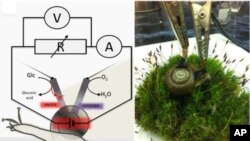Researchers have found a way to turn small living things, such as snails, cockroaches and mushrooms, into electronic "cyborgs," implanting them with tiny biofuel cells that draw and store electrical power from the organism's metabolic processes. With funding from the U.S. Defense Department, the work is aimed at creating bio-powered sensors for remote environmental monitoring and military applications.
Fruit energy
It started in 2003, with a grape. Chemical engineer Adam Heller and his colleagues at the University of Texas, Austin, implanted a biofuel cell - a special kind of micro-battery - into a grape and demonstrated that it could generate and store electricity by harnessing the energy of the fruit's natural metabolic processes - chemical reactions involving glucose and oxygen. The cell produced about 2.4 microwatts of electricity.
Heller originally envisioned using implanted biofuel cells for medical applications, for example, as thermometers located at wound sites to monitor increases in temperature caused by inflammation, or as targeted nerve stimulators. But the devices were never developed.
French scientists have taken up where Heller left off. They’re working on biocompatible fuel cells that could draw on the glucose and oxygen in circulating human blood to power low energy medical devices such as pacemakers and urinary sphincters for incontinent patients.
Electrified snails
Evgeny Katz and his team at Clarkson University in Pottstown, New York, are taking this cyborg technology in another direction. The researchers have implanted biofuel cells into tiny brown garden snails, says Katz. The idea is to tap the energy of the snail to power a variety of micro-devices, some with military applications, such as remote sensors that can monitor environmental toxins or transmit images of people coming and going.
"For example, guest sensors, video cameras. And then they can use some kind of wireless transmitting devices to transmit the information," said Katz.
The electrified snails are hearty and low maintenance, munching carrots to provide a steady trickle of power for months.
All plants and animals use glucose and oxygen for energy. Biofuel cells tap into this biochemical dynamo using two electrodes, which are thinner than a human hair and a few millimeters apart. Katz says the electrodes transfer electrons to the cells through two microcircuits, one that breaks down glucose, and the other that converts oxygen into water.
"If you can do it fast enough, if you do it efficiently enough, then you can extract electrical power," said Katz.
The challenge, adds Katz, is figuring out how to transmit cyborg electricity to sensing devices.
Cockroaches as sensing agents
Biofuel cells have also been implanted into beetles and cockroaches. Electrochemist Daniel Scherson of Case Western Reserve University in Cleveland, Ohio, is spearheading that work.
Researchers have created a device that controls the roaches’ physical movements using the insects' own nervous system. Now they want to implant biofuel cells into the roaches so the insects could be used to operate sensing devices capable of detecting poisonous agents like sarin gas.
Scherson also says it might someday be possible to wire tree sap for threats to the environment. "And then you can draw power from the sap for all materials that may be a threat to society," he said.
Scherson’s team is currently working to implant biofuel cells into Shiitake mushrooms.
The cyborg research has received funding from the U.S. Department of Defense.
Studies on biofuel cells by Daniel Scherson of Case Western Reserve University and Evgeny Katz of Clarkson University were published in the Journal of the American Chemical Society.




